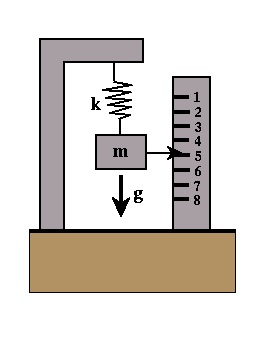
Mass and Spring Measurements
The most common type of gravimeter* used in exploration surveys is based on a simple mass-spring system. If we hang a mass on a spring, the force of gravity will stretch the spring by an amount that is proportional to the gravitational force. It can be shown that the proportionality between the stretch of the spring and the gravitational acceleration is the magnitude of the mass hung on the spring divided by a constant, k, which describes the stiffness of the spring. The larger k is, the stiffer the spring is, and the less the spring will stretch for a given value of gravitational acceleration.

Like pendulum measurements, we can not determine k accurately enough to estimate the absolute value of the gravitational acceleration to 1 part in 40 million. We can, however, estimate variations in the gravitational acceleration from place to place to within this precision. To be able to do this, however, a sophisticated mass-spring system is used that places the mass on a beam and employs a special type of spring known as a zero-length spring.

Gravity
- Overviewpg 12
- -Temporal Based Variations-
- Instrument Driftpg 13
- Tidespg 14
- A Correction Strategy for Instrument Drift and Tidespg 15
- Tidal and Drift Corrections: A Field Procedurepg 16
- Tidal and Drift Corrections: Data Reductionpg 17
- -Spatial Based Variations-
- Latitude Dependent Changes in Gravitational Accelerationpg 18
- Correcting for Latitude Dependent Changespg 19
- Vari. in Gravitational Acceleration Due to Changes in Elevationpg 20
- Accounting for Elevation Vari.: The Free-Air Correctionpg 21
- Variations in Gravity Due to Excess Masspg 22
- Correcting for Excess Mass: The Bouguer Slab Correctionpg 23
- Vari. in Gravity Due to Nearby Topographypg 24
- Terrain Correctionspg 25
- Summary of Gravity Typespg 26